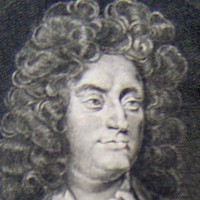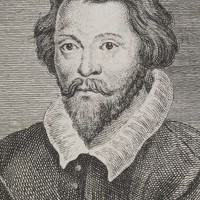Details

Henry Purcell arr. Leopold Sipe
Ceremonial Music

William Byrd
Sellinger’s Round

Michael Tippett
Divertimento on Sellinger's Round
After a slow start in music, Michael Tippett developed into one of the major British composers of the twentieth century. He studied at the Royal College of Music from 1923 to 1928, and then returned for counterpoint lessons from 1930 to 1932. His first mature works emerged in the mid-1930s, at the same time that he was developing his pacifist stance and coming to terms with his homosexuality. Tippett registered as a conscientious objector during World War II, which resulted in a three-month prison sentence in 1943. His trajectory improved the next year, when his breakthrough oratorio, A Child of Time, received a belated first performance.
In 1952, Tippett was one of six composers asked to contribute to the Variations on an Elizabethan Theme, a collaborative project spearheaded by Benjamin Britten. In honor of the upcoming coronation of Queen Elizabeth II, Britten proposed that each composer write a variation on a famous tune from the time of Queen Elizabeth I. The tune was “Sellinger’s Round,” as arranged by the Renaissance composer William Byrd (1543–1623). Tippett supplied the second variation, A Lament. Besides using the Byrd theme, Tippett also incorporated a quotation from Henry Purcell’s opera Dido and Aeneas, from the famous recitative and aria known as “Dido’s Lament.” Having already designed one variation, Tippett expanded his work into a complete piece of its own.
“Sellinger’s Round,” or alternatively “Sellenger’s Round,” was already a popular dance tune by the time of Byrd’s rendition, which first appeared in 1590. The tune was first known as “St. Leger’s Round,” sharing its name with a powerful family that entered England with the Norman conquest in 1066. John Playford included the melody in his seventeenth-century dance compendium, The Dancing Master, along with instructions for a circle dance for couples.
Tippett’s Divertimento on “Sellinger’s Round” looks at the tune five different ways, each time incorporating quotations from another composer. The opening Allegro dissects the theme with neoclassical fragmentation and imitative counterpoint. Additional music by the Renaissance composer Orlando Gibbons and the prominent use of oboe and bassoon reinforce the movement’s historical character.
The second movement, A Lament, frames the theme with excerpts from Purcell’s Dido and Aeneas and florid violin solos. The following Presto is wry and scherzo-like; it adds music by Thomas Arne, the eighteenth-century composer most famous for penning Rule, Britannia! The Adagio fourth movement is dark and moody, with angular passages of stacked fourths taking the music further from its Renaissance source. The additional composer featured here is John Field, an Irish pianist and composer who helped pioneer Romantic forms such as the Nocturne for solo piano. The Allegro Assai finale juxtaposes lively repetitions from the strings with dry interjections from the winds and brass. Tippett included music by Arthur Sullivan from Yeoman of the Guard (1888), the eleventh of fourteen comic operas by the team of Gilbert and Sullivan.
Aaron Grad ©2012

Johann Sebastian Bach arr. George Benjamin
Canon and Fugue from Art of the Fugue

Johann Sebastian Bach
Orchestral Suite No. 3
From 1723 until his death in 1750, Johann Sebastian Bach held the demanding position of Thomaskantor, directing music for the principal churches of Leipzig and training the young choristers under his care. Somehow in his spare time he also managed to lead the Collegium Musicum, an amateur ensemble that mounted weekly performances. The Collegium Musicum provided Bach an outlet where he could present secular music not fit for church — including his four Orchestral Suites — played by spirited local amateurs, his own sons among them.
Manuscript sources date the Orchestral Suite No. 3 to around 1731, with some of the parts in Bach’s own hand, and others written out by his son Emanuel. The term Bach would have used for such a work was Ouverture, the same heading given to the substantial first moved that he styled (and spelled) in the French manner. The second-movement Air, known familiarly as the “Air on the G String,” was made famous through a 19th-century rendition by violinist August Wilhelmj, who transposed the melody so he could play it all on his lowest string. An air, equivalent to the Italian “aria,” is a vehicle for song-like melodies, as opposed to the dancing styles that comprise the remainder of the suite.
The first dance form, the Gavotte, features a heavy pulse of two beats per measure, with the introductory upbeat of each phrase emphasized. In the sprightly Bourrée, trumpets and timpani enliven the pulse by accentuating the weak beats. The closing Gigue, a dance adapted in France from the jigs of the British Isles, retains the reeling triplet pulse of its folk source.
Aaron Grad ©2022
About This Program
This program leans into Baroque sensibilities, featuring orchestral music by the master himself, Johann Sebastian Bach, as well as 20th century composers who were inspired by his elaborate and intricate harmonies, unfurling a rich tapestry of sound that spans centuries. Opening the concert is an arrangement of Henry Purcell’s trumpet tunes, which occupies a special place in our history. In fact, this arrangement by the SPCO’s first music director, Leopold Sipe, was the very first piece performed in 1959 at the orchestra’s inaugural concert, which took place in the auditorium of St. Paul’s Central High for an audience of 150 people. In this SPCO musician-led concert, we explore our history and harken to our broader 2025.26 season throughline of performing each of Bach’s four orchestral suites, giving these timeless Baroque masterpieces their own time to shine.

